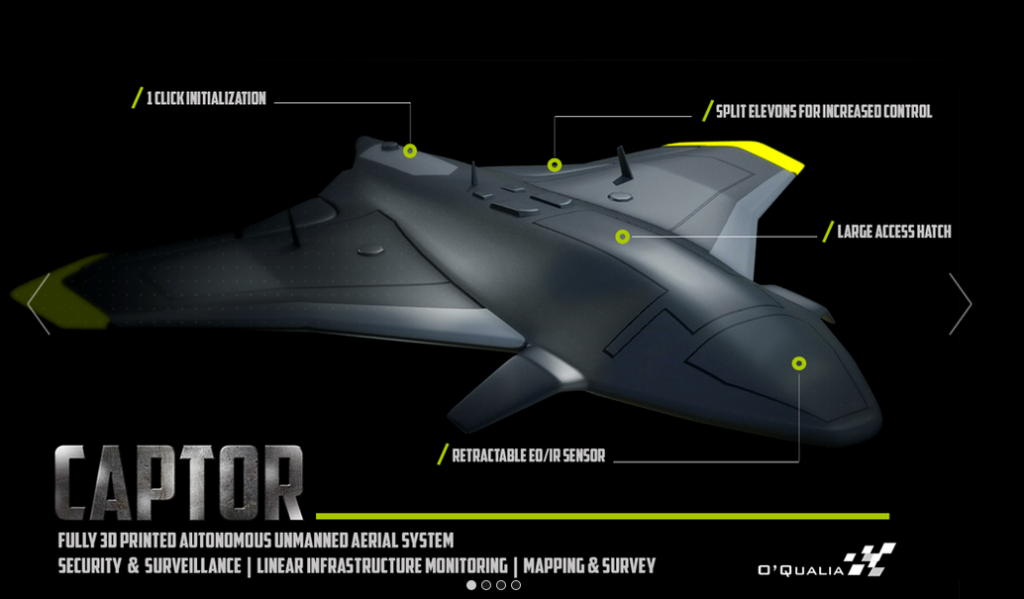O‘Qualia builds unmanned aerial systems for the industrial and natural resources sectors in the Asia-Pacific region, and it was founded by a team of Dutch entrepreneurs to deliver unmanned aerial systems (UAS) used to collect business intelligence.
The company arose out of, and still maintains, strategic ties to TU Delft, the oldest and largest Dutch technical university and takes on proprietary studies and rapid prototyping projects aimed at allowing their researchers to deliver reliable and commercially viable systems.
 O’Qualia says they’re dedicated to the “collective advancement of the unmanned systems and robotics industry.” Working from their manufacturing base in Singapore, they’ve just announced a new fixed-wing UAS designed for the security market. They say it’s the first aircraft in history fully manufactured with Fused Deposition Modeling technology.
O’Qualia says they’re dedicated to the “collective advancement of the unmanned systems and robotics industry.” Working from their manufacturing base in Singapore, they’ve just announced a new fixed-wing UAS designed for the security market. They say it’s the first aircraft in history fully manufactured with Fused Deposition Modeling technology.
It’s called the CAPTOR, and it’s manufactured from ABS draped with a carbon-reinforced skin. Featuring a wingspan of 2 meters, each CAPTOR is delivered in three parts which click neatly together in the field without the use of tools for assembly for ease and to shorten setup time.
“With the dynamic requirements of each individual client and the pace within which applications evolve – it just wasn’t cost-effective nor practical in certain scenarios to build a UAS the conventional way. We wanted to bring fully customisable solutions for our clients and saw the opportunity with 3D printing,” says M. Rashed, the Executive Consultant for O’Qualia. “O’Qualia has always been differentiated by its customisability and with CAPTOR, I’m confident that a new standard has been set in terms of speed to market and cost ratio. Manufacturing times have been reduced by half and we’ve reduced the cost to produce each UAS by at least 40%.”
With a maximum take off weight of 3.5 kg and designed to carry either the T707 EO/IR gimbal (designed in-house) or the CM100 (from UAV Vision), the CAPTOR is driven by a high torque electric motor and is capable of 2 hours flight time, reaching cruise speeds of 16 meters per second.
O’Qualia says those capabilities make the CAPTOR ideal for surveillance and monitoring applications.
E. Moseer, the Business Development Manager at O’Qualia, says that the use of FDM technology enabled them to deliver a cost-effective solution which is highly customizable to meet the changing requirements of their customer base. He adds that they expect the first fleet of devices to be delivered in July to one of their major clients in the Asia-Pacific market.
The two wings and fuselage of the CAPTOR fit together via a click-system, feature a specially designed aerofoil and a wide body which helps it generate lift and includes battery packs built to leave ample room to allow for the inclusion of additional sensors and payloads.
O’Qualia notes that a single-button initialization process is all that’s needed to accomplish pre-flight checks, that dual GPS receivers provide positional data redundancy, and that a standardized payload bay located in the nose of the vehicle includes a retractable EO/IR day and night sensor which is deployed and retracted automatically.
Can you think of any uses for the CAPTOR UAS system from O’Qualia? Let us know in the CAPTOR 3D Printed UAS forum thread on 3DPB.com.
Subscribe to Our Email Newsletter
Stay up-to-date on all the latest news from the 3D printing industry and receive information and offers from third party vendors.
You May Also Like
Precision at the Microscale: UK Researchers Advance Medical Devices with BMF’s 3D Printing Tech
University of Nottingham researchers are using Boston Micro Fabrication‘s (BMF) 3D printing technology to develop medical devices that improve compatibility with human tissue. Funded by a UK grant, this project...
3D Printing Webinar and Event Roundup: April 21, 2024
It’s another busy week of webinars and events, starting with Hannover Messe in Germany and continuing with Metalcasting Congress, Chinaplas, TechBlick’s Innovation Festival, and more. Stratasys continues its advanced training...
3D Printing Webinar and Event Roundup: March 17, 2024
It’s another busy week of webinars and events, including SALMED 2024 and AM Forum in Berlin. Stratasys continues its in-person training and is offering two webinars, ASTM is holding a...
3D Printed Micro Antenna is 15% Smaller and 6X Lighter
Horizon Microtechnologies has achieved success in creating a high-frequency D-Band horn antenna through micro 3D printing. However, this achievement did not rely solely on 3D printing; it involved a combination...






























